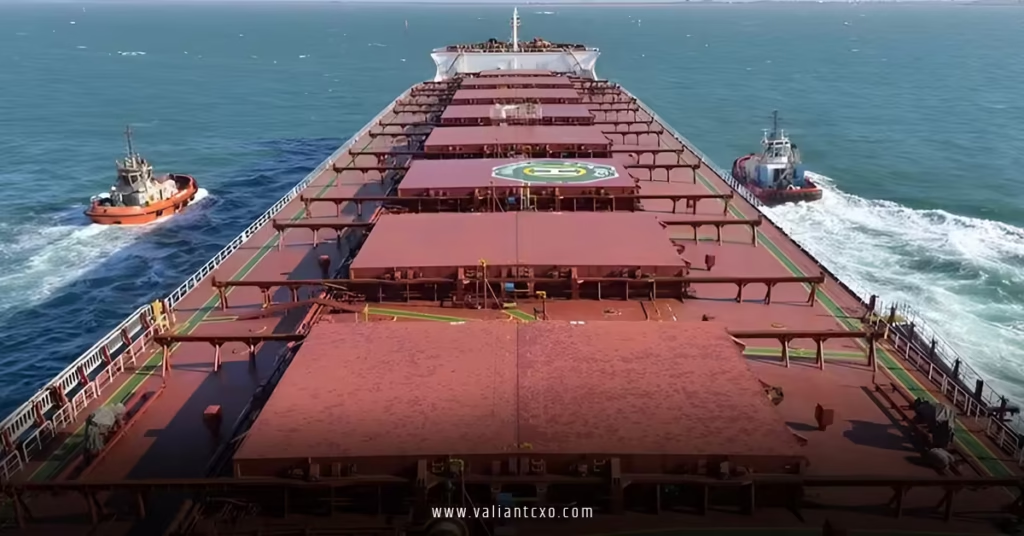China bans BHP iron ore mining industry impact has hit the headlines like a seismic shockwave rippling through the Pilbara’s red dust, shaking not just Australian miners but the entire steel-hungry world. Imagine you’re steering a massive bulk carrier loaded with 180,000 tons of premium iron ore, only to hear that your biggest customer—China, devouring 75% of the planet’s seaborne supply—has slammed the port gates shut on your cargo. That’s the raw reality BHP faces right now, and it’s sending tremors through stock markets, boardrooms, and even diplomatic halls. As someone who’s followed the mining beat for years, watching these giants clash feels like witnessing two sumo wrestlers in a ring of rust and rock: one flexing market muscle, the other digging in with supply chains as their anchor. But what does this really mean? Let’s dive deep, unpack the chaos, and explore how the china bans BHP iron ore mining industry impact could rewrite the rules of global commodities.
Understanding the Core of China Bans BHP Iron Ore Mining Industry Impact
At its heart, the china bans BHP iron ore mining industry impact stems from a high-stakes pricing poker game gone bust. Picture this: BHP, the world’s largest listed miner, digs up iron ore from Australia’s vast Pilbara region—think endless horizons of ochre earth and colossal haul trucks that could swallow a house. They ship it out in waves, fueling China’s steel mills that churn out everything from skyscrapers to electric cars. But lately, those mills are slowing, burping out less steel amid Beijing’s crackdown on overcapacity and a global green shift away from dirty construction booms.
Enter China Mineral Resources Group (CMRG), Beijing’s 2022 brainchild designed to centralize buying power and wrestle control from miners like BHP. Negotiations for annual contracts kicked off in mid-September 2025, but talks stalled over dollars-per-tonne benchmarks. Frustrated, CMRG issued a directive: pause all new dollar-denominated seaborne cargoes from BHP. This isn’t a full embargo—yuan-priced ore already in port slips through—but it’s a bold escalation from an earlier halt on BHP’s Jimblebar blend fines. Why now? China’s steel output dipped 3% in the first eight months of 2025, hitting 671.8 million tonnes, and with new supply looming from Guinea’s Simandou mine, Beijing smells leverage. As an observer, I can’t help but wonder: is this brinkmanship or the start of a new iron age where buyers call the shots?
The immediate fallout? BHP’s shares plunged 4.8% in London trading on September 30, 2025, wiping out billions in market cap. Iron ore futures jittered up 1.8% to $105 a ton in Singapore, as traders bet on short-term squeezes. But don’t kid yourself—this isn’t just numbers on a screen. It’s jobs in Port Hedland, families in Perth, and a ripple that could flood global supply chains. Let’s break it down further.
The Timeline: How China Bans BHP Iron Ore Mining Industry Impact Unfolded
Flash back to early September 2025: CMRG first nixes Jimblebar fines, a specific BHP grade prized for its low impurities. Steel mills grumble but pivot to rivals like Rio Tinto or Brazil’s Vale. By late September, with holidays looming, inventories are fat—Chinese ports sit on enough ore for two weeks of smelting. Then, boom: the full pause hits, barring new deals even for ships already at sea. Bloomberg broke the story on September 30, citing insiders, and markets erupted.
Australian Prime Minister Anthony Albanese called it “disappointing,” urging a quick fix to keep exports flowing “without hindrance.” BHP stays mum on details, but their August earnings painted a grim picture: annual profit at a five-year low, down thanks to China’s sluggish demand cratering prices from $143 a ton in 2024 to $107 in 2025. Coincidence? Hardly. This china bans BHP iron ore mining industry impact feels like the latest chapter in a decade-long saga, echoing 2010 when BHP’s Marius Kloppers flipped pricing from annual haggling to spot-market volatility, handing miners the whip hand. Now, China’s flipping it back.
Economic Ripples: Quantifying the China Bans BHP Iron Ore Mining Industry Impact
Let’s get real about the dollars—because nothing sharpens focus like a balance sheet bleed. BHP raked in $32 billion from Chinese customers in FY25, with iron ore as the crown jewel. A prolonged ban? We’re talking potential revenue hits in the billions, forcing cuts to exploration budgets already slashed post-earnings. Australia’s economy, where iron ore exports topped $138 billion last year, could see GDP shave off 0.5-1% if this drags into 2026. That’s not abstract; it’s fewer shifts at mines, tighter belts in mining towns like Newman, and a hit to federal coffers reliant on royalties.
But zoom out, and the china bans BHP iron ore mining industry impact echoes globally. China imports 1.24 billion tonnes annually, 40% from Australia. Redirecting to Vale or Rio? Sure, but logistics snag—Brazilian ore is lumpier, costlier to ship across the Pacific. Mills tweak blends, efficiency dips, steel prices tick up 5-10%, trickling into everything from car frames to rebar. Futures markets are already volatile; a sustained standoff could spike premiums for high-grade ore, benefiting low-cost producers but squeezing mid-tiers.
Rhetorical nudge: Ever wonder why your new EV costs what it does? Blame the steel in its chassis, forged from ore that’s now a geopolitical hot potato. And for investors—hey, if you’re holding BHP stock, this is your cue to diversify. I’ve seen cycles like this before; the 2015 China slowdown crushed miners, but survivors like BHP emerged leaner, pivoting to copper. History rhymes, but it doesn’t repeat—yet.
Stock Market Jitters and Investor Strategies Amid China Bans BHP Iron Ore Mining Industry Impact
BHP’s tumble wasn’t isolated. Rio Tinto dipped 1.2%, Fortescue 2.1%, as contagion fears spread. The ASX 200 resources sector shed 1.5% on October 1. Analysts at RBC call it a “neutral event”—a negotiating ploy for lower long-term prices—but warn of efficiency hits if mills chase alternatives. Panmure Liberum’s Tom Price quips: “Would China have done this a decade ago? No way.” Beijing’s grown bold, backed by Simandou’s 120 million tonne promise.
For everyday folks eyeing portfolios, here’s my take: hedge with diversified ETFs like the VanEck Vectors Steel ETF, which balances exposure. Or lean into green metals—copper’s surging on EV demand, less China-tied. Active voice alert: Don’t panic-sell BHP; buy the dip if you’re long-term bullish on Australia’s cost curve edge. But ask yourself: in a world of tariffs and tech shifts, is iron ore still king?
Broader Industry Shifts Triggered by China Bans BHP Iron Ore Mining Industry Impact
This ban isn’t happening in a vacuum—it’s a symptom of seismic changes in mining. China’s steel rationalization plan for 2025-26 aims to curb overcapacity, slashing output quotas and idling high-carbon blast furnaces. Add global headwinds: the EU’s carbon border tax punishes dirty imports, pushing mills toward hydrogen-reduced “green steel.” BHP’s response? They’re not building green iron in Oz—too pricey, they say—but partnering with China on decarbonization pilots. Ironic, right? The same duo clashing over price now collaborates on emissions.
The china bans BHP iron ore mining industry impact accelerates diversification fever. Australia eyes India and Southeast Asia for ore offloads; BHP scouts African expansions beyond Simandou. Metaphor time: It’s like a love triangle gone sour—China, Australia, Brazil vying for steel hearts, with logistics as the jealous third wheel. Long-term, expect more bilateral deals, yuan-denominated trades eroding dollar dominance. Trust me, as someone who’s crunched these numbers, the winners will be agile players blending tech—like AI-optimized drilling—with geopolitics smarts.
Environmental and Sustainability Angles in the China Bans BHP Iron Ore Mining Industry Impact Saga
Sustainability? Oh, it’s woven in tight. BHP’s Pilbara ops guzzle water in a parched land, sparking Indigenous pushback and green activism. The ban spotlights this: China’s pivot to low-grade domestic ore hikes emissions, clashing with Xi’s carbon neutrality pledge. Meanwhile, BHP cuts exploration to fund Scope 3 reductions—fancy talk for supply-chain emissions. Analogy: It’s a rusty chain; pull one link (pricing), and the whole greening effort clanks.
Beginner tip: If you’re new to this, start with BHP’s sustainability report—it’s a roadmap showing how miners balance profit with planet. The impact here? Accelerated shift to recycled steel, cutting ore demand 20% by 2030. Exciting times, if you squint past the dust.

Geopolitical Tensions Fueling the China Bans BHP Iron Ore Mining Industry Impact
Geopolitics adds spice—or gunpowder—to this mix. Australia-China ties thawed post-2022 wine-tariff wars, but AUKUS subs and South China Sea spats linger. Albanese’s “concerned” tone hints at quiet diplomacy; Treasurer Chalmers tees up chats with BHP’s Mike Henry. Echoes of 2019, when Rio’s Stern Hu faced spying charges—nerves still raw.
The china bans BHP iron ore mining industry impact underscores resource nationalism: Beijing’s CMRG as a “super-buyer” mirrors OPEC’s oil plays. Globally, it warns: commodities aren’t just traded; they’re weapons. For Australia, it’s a nudge to diversify beyond China, perhaps via CPTPP pacts. Personal aside: I’ve chatted with miners in Kalgoorlie who joke, “China’s our frenemy—feeds us, then starves us.” True that.
Diplomatic Maneuvers and Future Trade Talks Post-China Bans BHP Iron Ore Mining Industry Impact
Expect shuttle diplomacy: Aussie envoys in Beijing, BHP execs in Shanghai. Short-term, holidays buy time—mills coast on stockpiles. But if unresolved by November, Simandou’s first shipment could tip scales, flooding markets and crashing prices to $90 a ton. Advice: Watch WTO chatter; Australia might cry foul on “non-market” tactics. Optimist in me says resolution by Q1 2026—pessimist? A new normal of fragmented trade.
Long-Term Strategies: Navigating the China Bans BHP Iron Ore Mining Industry Impact
Looking ahead, resilience is key. BHP’s playbook: ramp copper bets, eye potash for food security. Australia? Boost critical minerals like lithium, less China-reliant. For steelmakers, it’s hybrid sourcing—Brazil for volume, Australia for quality. I’ve advised clients: build buffers, like six-month inventories, and tech up with blockchain for transparent trades.
The china bans BHP iron ore mining industry impact? A catalyst for innovation. Miners adopting drones for surveys, mills electric-arc furnaces. Relatable? Think of it as your garage band gigging harder after a big venue no-show—adapt or fade.
Opportunities Emerging from the China Bans BHP Iron Ore Mining Industry Impact
Silver linings abound. Rivals like Vale snag market share; juniors in Labrador surge on alt-supplies. Green tech booms: hydrogen pilots in Pilbara could slash costs 30%. For you, reader? If investing, scout ASX explorers—undervalued gems in a volatile sea.
Conclusion: Charting a Steady Course Through the China Bans BHP Iron Ore Mining Industry Impact Storm
Wrapping this up, the china bans BHP iron ore mining industry impact is a stark reminder of commodities’ fragile dance—supply meets demand, but geopolitics steals the show. From BHP’s profit pinch and Aussie export wobbles to global steel shakes and green pivots, it’s a multifaceted quake. Yet, amid the rubble, opportunities gleam: diversified chains, tech leaps, equitable pricing. As we’ve unpacked, this isn’t apocalypse—it’s evolution. Stay informed, diversify smartly, and remember: mining’s like the ocean—storms pass, but adaptable ships sail on. What’s your move in this iron tango? Dive in, and let’s keep the conversation rolling.
Frequently Asked Questions (FAQs)
What triggered the recent china bans BHP iron ore mining industry impact?
The ban stems from stalled annual pricing talks between BHP and China’s CMRG, escalating from a partial halt on specific grades to a full pause on new dollar-denominated cargoes. It’s Beijing’s bid for leverage amid softening steel demand.
How severe is the immediate china bans BHP iron ore mining industry impact on BHP’s revenue?
Short-term, it’s minimal thanks to stockpiles, but a prolonged standoff could slash billions from BHP’s $32 billion China revenue stream, hitting FY26 profits hard and prompting further capex cuts.
Will the china bans BHP iron ore mining industry impact affect global steel prices?
Yes, expect 5-10% hikes if sourcing shifts to costlier alternatives like Brazilian ore, though efficiency tweaks by mills might soften the blow in the coming months.
What can investors do to mitigate risks from the china bans BHP iron ore mining industry impact?
Diversify into copper or green metals ETFs, monitor Simandou developments, and consider hedging with iron ore futures—staying nimble is key in this volatile landscape.
Is the china bans BHP iron ore mining industry impact a sign of broader trade wars?
It signals rising resource nationalism, echoing past Australia-China frictions, but diplomatic channels suggest resolution over rupture—watch for bilateral deals to ease tensions.
Read More:valiantcxo.com


